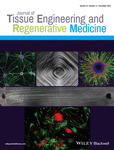Alteration of the extracellular matrix and alpha-gal antigens in the rat lung scaffold reseeded using human vascular and adipogenic stromal cells
Abstract
Regenerated organs are expected to solve the problem of donor organ shortage in transplantation medicine. One approach to lung regeneration is to decellularize the organ and reseed it with selected cells. An advantage of the procedure is reduced immunogenicity, because all cells can be theoretically replaced by autologous cells. However, little is known regarding the extracellular matrix (ECM) damage during decellularization and ECM reconstruction process in the organ regeneration. We aimed to evaluate ECM damage and reconstruction of the decellularized–recellularized rat lung, including the removal of alpha-gal xenoantigens. Rat lungs were perfused with sodium dodecyl sulfate and Triton X-100 via the pulmonary artery, after which the decellularized scaffold was reseeded with rat or human endothelial cells and adipose-derived stem cell (ASCs). The ECM and alpha-gal antigen were evaluated using immunohistochemistry, western blotting, and a glycosaminoglycan assay. Alcian blue staining revealed increased production of proteoglycan following the addition of ASCs to the rat lung recellularized with rat lung microvascular endothelial cells. Glycosaminoglycan levels decreased in the decellularized lung and increased in the recellularized lung, especially in the ASC-treated group. Immunohistochemical expression of the alpha-gal protein was decreased to an undetectable level in the decellularized lung tissue and disappeared after recellularization with human cells. In western blot analysis, the bands of alpha-gal protein almost disappeared after recellularization with human cells. In conclusion, characteristics of the regenerated ECM might depend on the species and type of cells used for recellularization. Therefore, alpha-gal antigen might be eliminated after a prolonged culture, when using human cells.
CONFLICT OF INTEREST
The authors have declared that there is no conflict of interest.




